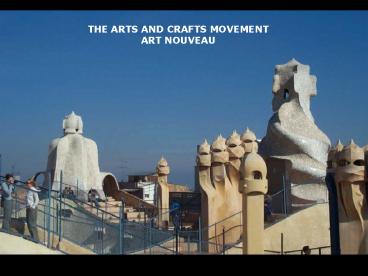THE ARTS AND CRAFTS MOVEMENT - PowerPoint PPT Presentation
1 / 38
Title:
THE ARTS AND CRAFTS MOVEMENT
Description:
Origin in graphic work, but later into design of objects and architecture. ... Glasgow School of Art, Glasgow, 1897. Mackintosh, The Tea Room. ... – PowerPoint PPT presentation
Number of Views:536
Avg rating:3.0/5.0
Title: THE ARTS AND CRAFTS MOVEMENT
1
THE ARTS AND CRAFTS MOVEMENT ART NOUVEAU
2
(No Transcript)
3
THE ARTS AND CRAFTS MOVEMENT THE ENGLISH
PHENOMENON John Ruskin, critique of
industrialism, and celebration of Gothic crafts
and ornament. William Morris, and the Domestic
Revival Anti-industrial aesthetics and
stylization. of nature in the design of domestic
objects and spaces. Celebrating the curvilinear
form. Charles Voysey, and the culmination of the
Domestic Revival. Charles Rennie Mackintosh (in
Glasgow), and the bridge to Art Nouveau. ART
NOUVEAU PARIS, BARCELONA AND VIENNA Art
Nouveau in Paris and Brusells, a curvilinear
fantasy made possible by tractable materials like
iron and glass. Origin in graphic work, but
later into design of objects and
architecture. Victor Horta in Brusells. Hector
Guimard in Paris. Antonio Gaudi in
Barcelona. Vienna Secession, a return to the
straight line but preserving the elegance of Art
Nouveau. Otto Wagner, architecture reflecting
modern life in modern materials. Joseph Olbrich,
organic vitality in architecture and return to
the unconscious. Josef Hoffman, conscious
denial of surface and mass.
4
John Ruskin
William Morris
5
The writings of Ruskin and Morris Gothic
emotionalism A social vision critiquing
industrialism Glorification of ornament Domestic
Revival Celebration of the English House The
Arts and Crafts Movement Total Art The Arts
and Crafts Movement Formally institutionalized
by 1880s, with the Domestic Revival as an
outcome. The Domestic Revival saw architectural
attention to modest, middle-class houses. The
structures were mostly informal, asymmetrical,
anti-classical, unpretentious, and exhibited
comfortable domestic virstues.
John Ruskin
William Morris
6
Domestic Revival resulted from the following
factors Desire to return to the imagined ease
and simplicity of a pre-industrial life. A
specific pre-industrial mode Not the classical,
not even the Gothic, but From the Tudor Period to
the 18th century. Eclecticism Architects free to
choose and combine elements.
7
Ruskins view of the Gothic Imperfection is in
some sense essential to all that we know of
life. Changefulness is a necessity. Lead to
naturalism or love of natural objects. Sense of
the grotesque, or the tendency to delight in the
fantastic and ludicrous. Ornamentation as
glorification of labor.
Learning from the Gothic and nature Drawings by
John Ruskin
8
Illustrations by William Morris
9
William Morris brought into practice the theories
of Ruskin Organized a group that designed and
made furniture, fabrics, wallpaper, Carpets,
stained glass, and objects of the house interior.
10
(No Transcript)
11
The Pre-Raphaelite Brotherhood aimed to create
art derived directly from nature, And not from
any artistic conventions as the Renaissance.
Drawing by Edward Burne-Jones
12
The creation as a total work of art. Philip Webb
and William Morris, The Red House, Kent, 1859
13
(No Transcript)
14
Philip Webb, The Green Room.
15
Richard Norman Shaw The Vicarage, Bedford Park.
16
Charles Voysey, Moorcrag.
17
(No Transcript)
18
(No Transcript)
19
(No Transcript)
20
Charles Rennie Mackintosh, Furniture and objects.
21
Mackintosh, Glasgow School of Art, Glasgow, 1897.
22
Mackintosh, The Tea Room.
23
The Arts and Crafts Movement in America Greene
and Greene, Gamble House, Pasadena, 1907
24
THE ART NOUVEAU MOVEMENT
25
Victor Horta, House Tassel, Brusells, 1898
26
August Endell, Elvira Photogrpahic Studio,
Munich, 1896.
27
Hector Guimard, Metro Entrances, Paris, 1899-1904
28
Guimard, Castel Beranger, Paris, 1894.
29
The Vienna Secessionist Movement
30
Otto Wagner, Karlplatz Station, Vienna.
31
Otto Wagner, Church, Vienna.
32
Otto Wagner, Postal Saving Bank, Vienna, 1904
33
Joseph Olbrich, Building for the Secession,
Vienna, 1898
34
Olbrich, House and Museum, Darmstadt, 1890s.
35
Antonio Gaudi, Sagrada Familia, Barcelona begun
1887
36
Gaudi, Parc Guell, Barcelona 1900
37
Gaudi, Casa Mila, Barcelona 1905
38
(No Transcript)































